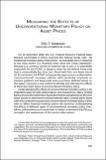Mostrar el registro sencillo del ítem
Measuring the effects of unconventional monetary policy on asset prices
| dc.contributor.author | Swanson, Eric T. | |
| dc.coverage.spatial | ESTADOS UNIDOS | es_ES |
| dc.date.accessioned | 2019-11-01T00:07:32Z | |
| dc.date.available | 2019-11-01T00:07:32Z | |
| dc.date.issued | 2016 | |
| dc.identifier.isbn | 978-956-7421-52-7 | |
| dc.identifier.uri | https://hdl.handle.net/20.500.12580/3850 | |
| dc.description | On 16 December 2008 the U.S. Federal Reserve’s Federal Open Market Committee (FOMC) lowered the federal funds rate—its traditional monetary policy instrument—to essentially zero in response to the most severe U.S. financial crisis since the Great Depression. Because U.S. currency carries an interest rate of zero it is essentially impossible for the FOMC to target a value for the federal funds rate that is substantially less than zero. Faced with this zero lower bound (ZLB) constraint the FOMC subsequently began to pursue alternative 'unconventional' monetary policies with particular emphasis on forward guidance and large-scale asset purchases (defined below). In this paper I propose a new method to identify and estimate the effects of these two main types of unconventional monetary policy. | |
| dc.format | ||
| dc.format.extent | Sección o Parte de un Documento | |
| dc.format.medium | p. 105-130 | |
| dc.language.iso | eng | |
| dc.publisher | Banco Central de Chile | |
| dc.relation.ispartof | Series on Central Banking Analysis and Economic Policies no. 24 | |
| dc.rights | Attribution-NonCommercial-NoDerivs 3.0 Chile | * |
| dc.rights.uri | http://creativecommons.org/licenses/by-nc-nd/3.0/cl/ | * |
| dc.subject | POLÍTICA MONETARIA | es_ES |
| dc.subject | PRECIOS | es_ES |
| dc.subject | TASAS DE INTERÉS | es_ES |
| dc.title | Measuring the effects of unconventional monetary policy on asset prices | |
| dc.type.doc | Artículo | |
| dc.file.name | BCCh-sbc-v24-p105_130 |


